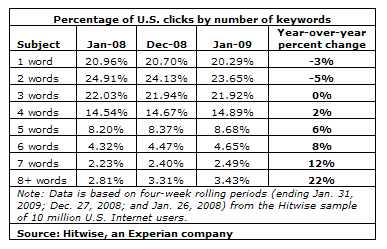SEO for Multi-Word Queries

The length of search queries has increased over the past year according to HitWise (PDF). That's a meaningful bit of information for both publishers (affiliates) and advertisers - let's look at how to capitalize on this important data.
Longer search queries, averaging searches of 5+ words in length, have increased 10 percent comparing January 2009 to January 2008. The same time period showed that shorter search queries, averaging those 1 to 4 words in length, have decreased 2 percent. Is it time to shift the focus of your SEO or SEM campaign?

The theory behind the long tail is based on the notion that the top 20% of the sales of a particular business represents only a small portion of the available market. This percentage is placed at the "head" of the demand curve while a large number of niches "tail" behind it.
The entire theory relies on the fact that, while most businesses mainly focus on the products/services that can be considered "hits" or "best-sellers", there are so many areas that remain untouched. If the idea has done anything, it has opened the eyes of Web professionals towards the immense opportunity of attracting and transforming more prospects into customers.
The problem is that not many merchants have yet acted on the opportunity present in the tail.
There are benefits and disadvantages to the rise in use of multiple-word queries. Long tail keywords arguably lead to higher conversions since it can be assumed that users conducting queries on those terms are further down the purchase funnel (they know exactly what they are looking for, right?). But are the visitors that arrive through multi-phrase search queries actually more likely to make purchases or convert on affiliate programs or publisher recommendations? The common/popular logic says yes, yes indeed.
By targeting long tail phrases, the value proposition of "better targeting a market of potential buyers" is clear, but the downside is not so obvious. We are collectively forced to do a lot more SEO leg work to make consumers aware of products or services. Factor in all the time it takes to optimize for long tail terms and it may be a wash in the end. The worst case scenario is that those sites which do not engage in long-tail SEO could ultimately be bypassed altogether and that's reason enough to test the waters.
The upside might just be greatest for affiliates. Those that identify a long tail niche (regardless of the keyword) will not only see an increase in traffic over time (thanks to less competition on the SERPs), but since consumers are farther down the purchasing funnel they'll inevitably see an increase in conversions. Either way you look at it - it's not good for those enterprises that are not currently engaged in some variation of long-tail SEO or at least are not aware of the possibilities.
The upside for those that do take long-tail terms seriously is the higher monetization potential. We all know that search engine visitors are valuable and are so because they are targeted individuals who are seeking specific information and hence are more likely to click on contextual ads or subscribe to your site newsletter or blog feed, or, and most importantly - buy a product or subscribe to a service. This presents an opportunity to grows an audience and allows for greater monetization potential in the long run through product sales or the use of third-party ad networks.
Chasing the Long Tail
Before you run off and start "chasing" the long tail, keep in mind that most of the techniques used for "regular" SEO will also apply to long tail SEO. There are some subtle differences however and it's essential they be mentioned.
Perhaps the simplest way to make the most of the long tail is leverage extended keyword combinations. While it's common in SEO to optimize for keywords in groups of three, it's best practice in long-tail SEO to acknowledge the presence of five or six term phrases. Ultimately, the the more specific one gets by extending the specificity of the keyphrase, the better the chances of acquiring targeted traffic.
Modifying site maps with descriptive, keyword rich "long tail" phrases will provide an additional layer of data for search engines and make it clear to users seeking access to the content they really need. Additional on-site SEO tactics should include modifying existing links and their anchor text with the long-tail terms being optimized for.
Embrace the Long Tail
The concept of the long-tail in SEO allows websites to offering highly customized products to their consumers directly from the SERPs (search result pages). While considerable effort is necessary to make this approach profitable (even feasible), the inevitable payoff is appealing.









